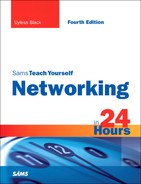Table of Contents
HOUR 1: An Overview of Networking
What Is a Network? What Is Networking?
The Network Architecture: Combining the Physical and Logical Components
Two Varieties of Networks: Local and Wide Area
How the Internet Relates to Your Network
Intranets, Extranets, and internets
HOUR 2: The Benefits of Networking
Computing Before Computer Networks
Networking’s Breakthrough: Packet-Switched Data
HOUR 3: Getting Data from Here to There: How Networking Works
The OSI Model (and Why You Should Be Familiar with It)
Addresses: Network or Layer 3 Addresses
MAC or Layer 2 Address: That Is to Say, Ethernet Addresses
Using Addresses to Relay Traffic
Overview of the Principal Protocols
And Farewell NetBIOS and NetBEUI
Numbers, Magnitudes, and Fractions
Operating System (OS) and Other Software
HOUR 6: Extending LANs with Wide Area Networks (WANs)
User-Network Interface, Inner-Network Interface, and Network-Network Interface
Layer 1 WAN Carrier Systems: T1 and SONET
Layer 2 for WANs: ATM and MPLS
HOUR 7: Mobile Wireless Networking
Understanding Wireless Networking
A Brief History of Mobile Wireless Networks
Are Wi-Fi and Bluetooth in Competition?
Frequency Interference Between Wi-Fi and Bluetooth?
Security Considerations with Wireless Networks
Remote Control for System Administration
Modern Remote Access Protocols and Procedures
The Point-to-Point Protocol (PPP)
Using the Internet for Remote Access: The VPN
Remote Access Hardware: Build or Buy?
HOUR 9: Planning for the Network
Best Practices and Building Computer Networks
Planning Best Practices: Plan, Design, Implement, and Tune
Interoperability by Using Standards
Improving Security Using Best Practices
Step 1: Identify the Uses of the Network
Step 2: List Which Tasks Execute on Which Computers
Step 3: Select the Type of Network: To Centralize or Not to Centralize
Step 5: Write the Specification
HOUR 11: Selecting Network Hardware and Software
Evaluating the Server Hardware
Evaluating the “Interworking” Hardware
Hardware Selection Considerations for Ethernet Networks
Selecting the Network Type: Client/Server or Peer to Peer
Peer-to-Peer Networking with Microsoft Windows
A Word Regarding Network Protocols
A Word About Wireless Networking
A Sampler of Network-Based Applications
HOUR 14: Connecting to the Internet: Initial Operations
Considerations for Choosing an ISP
How and Why TCP/IP Was Created
HOUR 15: Connecting to the Internet: Key Supporting Operations
Configuring Network Devices with IP Addresses
Ideas for Establishing a Website
Microsoft’s Logical Network Structure
Installing and Configuring a Microsoft Server
Configuring Network Protocols in Windows
Sharing Folders and Printers on the Network
HOUR 17: UNIX and Linux Networking
UNIX/LINUX as a Network Platform
Network Services and Settings on a Linux Server
HOUR 18: Putting the Pieces Together
Review of Internet Layered Model
Key Network Components’ Position in the Layers
Names, Addresses, and Sockets: The Cogs of Communications
Relationships of Names, Addresses, and Sockets
Common Locations of Components at Network Interfaces
HOUR 19: Role of the Network Administrator
Computer Networking Education and Certification
Additional Thoughts on Managing the Planning and Installation Processes
Protecting the Internal Network from External Attacks
Best Practices for Securing a Network
Managing Hardware Upgrades and Growth
Managing Software Upgrades and Growth
Dealing with NOS and Client Licensing
Network and Disaster Recovery Planning
HOUR 22: Network Troubleshooting
Hard Drive Performance and Space
Using Event Logs to Track Problems
TCP/IP Connectivity Command-Line Tools
HOUR 23: A Day in the Life of a Network Administrator
Strategies for Supporting Users
HOUR 24: Where Are Networks Going from Here?
Nationwide Variation of Wi-Fi: WiMax
